4 Artillery Regiment (South Africa)
4 Artillery Regiment is based at Potchefstroom, responsible for the training of soldiers allotted to Field and Medium Artillery.
| 4 Field Artillery | |
|---|---|
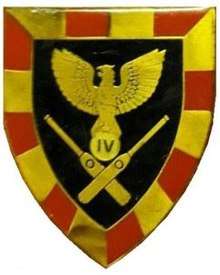 SANDF 4 Artillery Regiment emblem | |
| Active | 1945 to present |
| Country | |
| Allegiance | |
| Branch | |
| Type | Regular artillery |
| Role | Medium (self propelled) Artillery (G6) |
| Size | Regiment |
| Part of | South African Army Artillery Formation Army Conventional |
| Garrison/HQ | Potchefstroom, Northwest Province |
| Patron | St Barbara |
| Motto(s) | Always in support |
| Colors | The launchers |
| Anniversaries | 29 June |
| Equipment | GV6 155 mm self-propelled howitzer |
| Engagements | World War II South African Border War |
| Battle honours | South-West Africa |
| Insignia | |
| Collar Badge | Bursting grenade with seven flames |
| Beret Colour | Oxford Blue |
| Artillery Battery Emblems | 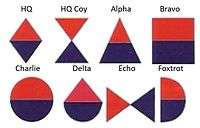 |
| Artillery Beret Bar circa 1992 |  |
History
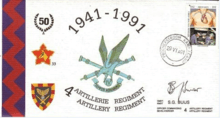
Origins
Under the UDF
On May 28, 1945, authority was granted for the formation of 4 Field Artillery as a full-time regiment with effect 1 April 1945.
Successor to 4 Field Brigade
4 Artillery was the successor to 4 Field Brigade, which had made a name for itself at Combolcia, Dessie and Amba Alagi in Ethiopia. The regiment served at El Alamein under its own name – as part of 1 SA Division – and in Italy as part of 6 SA Armoured Division, notably at Monte Stanco.
In May 1946 the unit became part of the Permanent Force's 11 Armoured Brigade. When the latter was disbanded in 1951, the unit continued on as 10 Field Battery.
4 Field Training Regiment
Based in Potchefstroom, it became 4 Field Training Regiment in 1953 with 10, 11 and 12 Field Batteries at Potchefstroom, Bloemfontein and Oudtshoorn respectively. It was disestablished as a training institution in November 1967.It continued as 4 field Regimentfrom 1967 to 1975 with 41 and 42 batteries based at Potchefstroom
and 43 battery in Walvis Bay
Under the SADF
Border War
The Regiment reactivated in 1975 and took part in most operations since Operation Savannah in 1976. It was back in action in August and September 1981 in support of Operation Protea. In 1983 the Regiment became part of 10 Artillery Brigade (with 14 Artillery Regiment) and was renamed 4 Artillery Regiment the next year. By 1987 4 Artillery was structured as:
- 41 Battery
- 42 Battery
- 43 Battery and
- 1 Medium Battery
In 1987 the Regiment took part in Operation Moduler and in 1988 in Operation Hooper, Operation Displace and Operation Prone. In 1989, the Regiment was part of the Merlyn Brigade based at Grootfontein, returning home after Namibian independence. The Artillery Brigade and 14 Artillery Regiment disbanded on January 1, 1993.
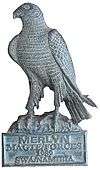
Internal operations
In 1985 and 1986 the unit had tours as provisional infantry in Soweto, Tembisa, Alexandra and in the KwaNdebele homeland.
Under the SANDF
Organisation

The regiment is currently organised as a composite unit and has a growth capability for the establishment of additional regiments if required:
- 4 Regimental Support Battery (4 RSB)
- 41 (Papa) Battery Soltam M-65 120mm mortar
- 42 (Quebec) Battery G6 155mm Gun/Howitzer
- 43 (Romeo) Battery Bateleur FV2 127mm multiple rocket launcher
- 44 (Sierra) Battery G5 155mm Gun/Howitzer
- 45 Battery Target Acquisition Bty
Regimental Colours
In March 1973 the unit broke with artillery tradition, which recognises the unit’s guns as its colours, and took possession of a regimental colour, becoming the first artillery regiment to be presented with a regimental colour and claims to be the first to have appointed an honorary colonel.
Insignia
Previous Dress Insignia
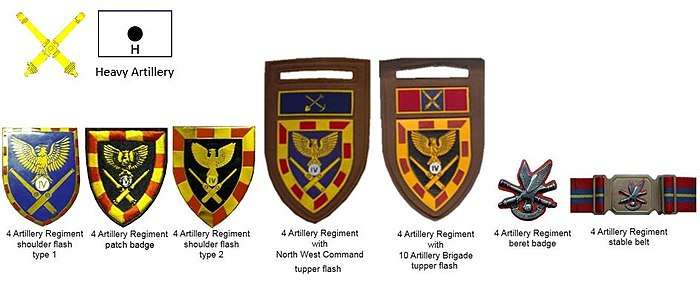
Leadership
- Col (Hon) Johann Oosthuizen 1984 – 2012
- Lt Col Nick Bierman CBE 1946 – 1947
- Lt Col Bob Meintjies DSO 1950 – 1953
- Cmdt Sarel Buijs 1991
- Col Deon Holtzhausen 1994 – 1997
- Lt Col Sarel Kruger
- Lt Col Thulani Zungu
- Lt Col André J. Claassen 2004-2006
- Lt Col Victor Khasapane 2006 – 2010
- Lt Col Jongile Maso 2014 – 2016
- Lt Col Mimy Matimbe 2017 – current
Freedom of the City
The regiment was awarded the Freedom of Potchefstroom in 1984.